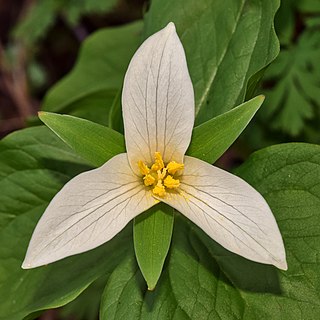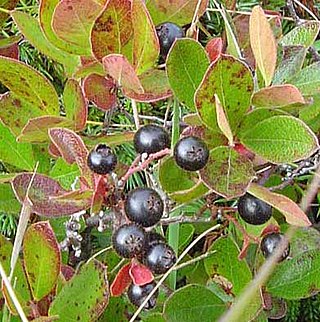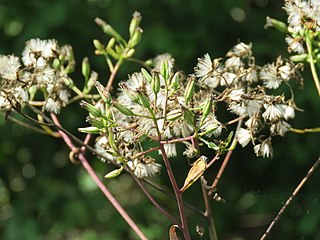
Trillium is a genus of about fifty flowering plant species in the family Melanthiaceae. Trillium species are native to temperate regions of North America and Asia, with the greatest diversity of species found in the southern Appalachian Mountains in the southeastern United States.

Canarium is a genus of about 100 species of tropical and subtropical trees, in the family Burseraceae. They grow naturally across tropical Africa, south and southeast Asia, Indochina, Malesia, Australia and western Pacific Islands; including from southern Nigeria east to Madagascar, Mauritius, Sri Lanka and India; from Burma, Malaysia and Thailand through the Malay Peninsula and Vietnam to south China, Taiwan and the Philippines; through Borneo, Indonesia, Timor and New Guinea, through to the Solomon Islands, Vanuatu, New Caledonia, Fiji, Samoa, Tonga and Palau.

Canarium ovatum, the pili, is a species of tropical tree belonging to the genus Canarium. It is one of approximately 600 species in the family Burseraceae. C. ovatum are native to the Philippines. They are commercially cultivated in the Philippines for their edible nuts and is believed to be indigenous to that country. The fruit and tree are often vulgarized with the umbrella term of "Java almond" which mixes multiple species of the same genus, Canarium.

Phyteuma is a genus of flowering plants in the family Campanulaceae, native to Europe and Morocco.

Phyteuma ovatum is a flowering plant in the family Campanulaceae.

Trillium ovatum, the Pacific trillium, also known as the western wakerobin, western white trillium, or western trillium, is a species of flowering plant in the family Melanthiaceae. It is found in western North America, from southern British Columbia and the tip of southwestern Alberta to central California, east to Idaho and western Montana. There is an isolated population in northern Colorado and southern Wyoming.

Vaccinium ovatum is a North American species of flowering shrub known by the common names evergreen huckleberry,winter huckleberry,cynamoka berry and California huckleberry.

Huckleberry Botanic Regional Preserve is a 241 acres (0.98 km2) regional park and nature reserve in the Oakland Hills, in the eastern East Bay region of the San Francisco Bay Area of California. It is within Alameda and Contra Costa Counties. It is a park within the East Bay Regional Parks District system. The Preserve is named after the California Huckleberry which grows abundantly within its habitat.
Tillicum or Tilikum is a word in Chinook Jargon that means people, family, tribe, and relatives, and may refer to:

Huckleberry is a name used in North America for several plants in the family Ericaceae, in two closely related genera: Vaccinium and Gaylussacia.

Trichostema ovatum is an uncommon species of flowering plant in the mint family known by the common name San Joaquin bluecurls.

The Pottiaceae are a family of mosses. They form the most numerous moss family known, containing nearly 1500 species or more than 10% of the 10,000 to 15,000 moss species known.

Tat Ton National Park is a national park in Chaiyaphum Province, Thailand. The park is in the Laen Kha mountain range. It features waterfalls and mountain highland scenery. On 31 December 1980, Tat Ton was designated Thailand's 23rd national park.

Rhododendron ovatum is an elepidote rhododendron species native to China and Taiwan. It is the type species for the subgenus, Azaleastrum.
Trillium crassifolium is a species of flowering plant in the bunchflower family Melanthiaceae. It is endemic to the Wenatchee Mountains in the U.S. state of Washington.

Arnoglossum ovatum, the ovateleaf cacalia, is a species of plant in the sunflower family. It is native to the southeastern and south-central United States from southern North Carolina to Florida and eastern Texas.
Peterodendron is a monotypic genus of flowering plants belonging to the family Achariaceae. The only species is Peterodendron ovatum.

Gompholobium ovatum is a species of flowering plant in the family Fabaceae and is endemic to the south-west of Western Australia. It is an erect or prostrate shrub with egg-shaped leaves and yellow and red to purple, pea-like flowers.
Trillium hibbersonii is a species of flowering plant in the bunchflower family Melanthiaceae. The specific epithet hibbersonii honors the English Canadian surveyor John Arthur Hibberson (1881–1955) who first collected this plant in 1938 on Vancouver Island in British Columbia. Hibberson and his son propagated the trilliums, selling them to buyers in England and other European countries. In 1968, Leonard Wiley coined the Latin name Trillium hibbersonii, a name that has since been used by horticulturists without reservation.
Trillium scouleri is a species of flowering plant in the bunchflower family Melanthiaceae.















